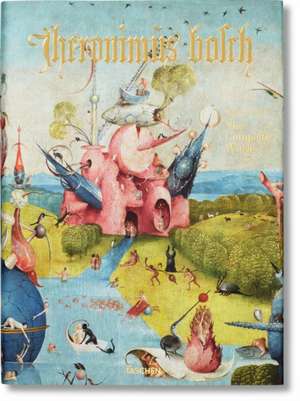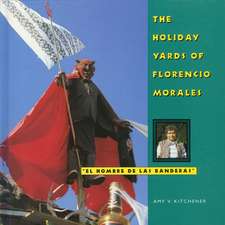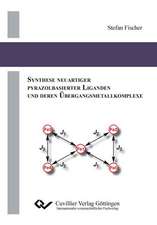Hieronymus Bosch: The Complete Works
Autor Stefan Fischeren Limba Engleză Hardback – 31 dec 2013
In the midst of the realist-leaning artistic climate of the Late Gothic and Early Renaissance, Dutch painter Hieronymus Bosch (c. 1450–1516) was more than an anomaly. Bosch’s paintings are populated with grotesque scenes of fantastical creatures succumbing to all manner of human desire, fantasy, and angst. One of his greatest inventions was to take the figural and scenic representations known as drolleries, which use the monstrous and the grotesque to illustrate sin and evil, and to transfer them from the marginalia of illuminated manuscripts into large-format panel paintings. Alongside traditional hybrids of man and beast, such as centaurs, and mythological creatures such as unicorns, dragons, and griffins, we also encounter countless mixed creatures freely invented by the artist. The devils in Bosch’s paintings are variously hunchbacked, birdlike, bespectacled, or wear an upturned funnel with a withered twig poking out of the top of their head—a symbol of carnal desire and intemperance—and hence appear as the embodiment not just of evil but also of the ugly and the ridiculous. Many subsidiary scenes illustrate proverbs and figures of speech in common use in Bosch’s day. In his Temptation of St Anthony triptych, for example, the artist shows a messenger devil wearing ice skates, evoking the popular expression that the world was "skating on ice"—meaning it had gone astray. In his pictorial translation of proverbs, in particular, Bosch was very much an innovator.
Bosch—whose real name was Jheronimus van Aken—remained closely tied all his life to his native s’-Hertogenbosch, the city from which he took his name as a painter. Bosch’s works were widely copied and imitated: the number of surviving works by Bosch’s followers exceeds the master’s own production by more than tenfold. Today only 20 paintings and eight drawings are confidently assigned to Bosch’s oeuvre. He continues to be seen as a visionary, a portrayer of dreams and nightmares, and the painter par excellence of hell and its demons. In this exhaustive book, which covers his complete works, art historian and acknowledged Bosch expert Stefan Fischer examines just what it was about Bosch and his painting that proved so immensely influential.
Bosch—whose real name was Jheronimus van Aken—remained closely tied all his life to his native s’-Hertogenbosch, the city from which he took his name as a painter. Bosch’s works were widely copied and imitated: the number of surviving works by Bosch’s followers exceeds the master’s own production by more than tenfold. Today only 20 paintings and eight drawings are confidently assigned to Bosch’s oeuvre. He continues to be seen as a visionary, a portrayer of dreams and nightmares, and the painter par excellence of hell and its demons. In this exhaustive book, which covers his complete works, art historian and acknowledged Bosch expert Stefan Fischer examines just what it was about Bosch and his painting that proved so immensely influential.
Preț: 978.13 lei
Preț vechi: 1270.29 lei
-23% Nou
Puncte Express: 1467
Preț estimativ în valută:
187.16€ • 195.41$ • 154.90£
187.16€ • 195.41$ • 154.90£
Carte disponibilă
Livrare economică 14-28 martie
Livrare express 28 februarie-06 martie pentru 165.15 lei
Preluare comenzi: 021 569.72.76
Specificații
ISBN-13: 9783836526296
ISBN-10: 3836526298
Pagini: 306
Dimensiuni: 318 x 457 x 51 mm
Greutate: 4.47 kg
Editura: Taschen Books
Colecția Taschen
ISBN-10: 3836526298
Pagini: 306
Dimensiuni: 318 x 457 x 51 mm
Greutate: 4.47 kg
Editura: Taschen Books
Colecția Taschen
Notă biografică
The author:
Stefan Fischer studied art history, history and classical archaeology in Münster, Amsterdam and Bonn. In 2009 he completed his doctoral thesis on “Hieronymus Bosch: Malerei als Vision, Lehrbild und Kunstwerk”. His specialist fields are Netherlandish painting of the 15th to the 17th century and museology.
Stefan Fischer studied art history, history and classical archaeology in Münster, Amsterdam and Bonn. In 2009 he completed his doctoral thesis on “Hieronymus Bosch: Malerei als Vision, Lehrbild und Kunstwerk”. His specialist fields are Netherlandish painting of the 15th to the 17th century and museology.
Descriere
In the midst of the realist-leaning artistic climate of the Late Gothic and Early Renaissance, Dutch painter Hieronymus Bosch (c. 1450–1516) was more than an anomaly.
Bosch’s paintings are populated with grotesque scenes of fantastical creatures succumbing to all manner of human desire, fantasy, and angst.
One of his greatest inventions was to take the figural and scenic representations known as drolleries, which use the monstrous and the grotesque to illustrate sin and evil, and to transfer them from the marginalia of illuminated manuscripts into large-format panel paintings.
Alongside traditional hybrids of man and beast, such as centaurs, and mythological creatures such as unicorns, dragons, and griffins, we also encounter countless mixed creatures freely invented by the artist.
The devils in Bosch’s paintings are variously hunchbacked, birdlike, bespectacled, or wear an upturned funnel with a withered twig poking out of the top of their head—a symbol of carnal desire and intemperance—and hence appear as the embodiment not just of evil but also of the ugly and the ridiculous.
Many subsidiary scenes illustrate proverbs and figures of speech in common use in Bosch’s day.
In his Temptation of St Anthony triptych, for example, the artist shows a messenger devil wearing ice skates, evoking the popular expression that the world was "skating on ice"—meaning it had gone astray. In his pictorial translation of proverbs, in particular, Bosch was very much an innovator.
Bosch—whose real name was Jheronimus van Aken—remained closely tied all his life to his native s’-Hertogenbosch, the city from which he took his name as a painter. Bosch’s works were widely copied and imitated: the number of surviving works by Bosch’s followers exceeds the master’s own production by more than tenfold.
Bosch—whose real name was Jheronimus van Aken—remained closely tied all his life to his native s’-Hertogenbosch, the city from which he took his name as a painter. Bosch’s works were widely copied and imitated: the number of surviving works by Bosch’s followers exceeds the master’s own production by more than tenfold.
Today only 20 paintings and eight drawings are confidently assigned to Bosch’s oeuvre. He continues to be seen as a visionary, a portrayer of dreams and nightmares, and the painter par excellence of hell and its demons. In this exhaustive book, which covers his complete works, art historian and acknowledged Bosch expert Stefan Fischer examines just what it was about Bosch and his painting that proved so immensely influential.





